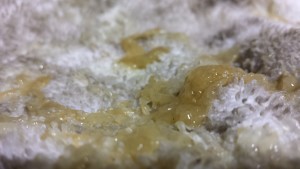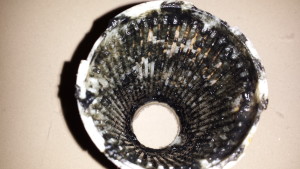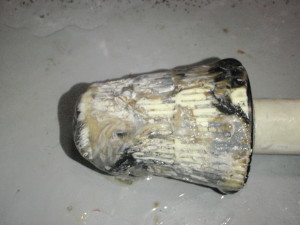Waterborne infectious diseases are diseases caused by bacteria, virus, or protozoa that spread through contaminated drinking water. Common examples include adenovirus, cholera, dysentery, legionellosis, hepatitis, norovirus, and giardiasis. Symptoms will vary, but nausea, vomiting, and diarrhea, with or without fever, are the most common. It’s common for people to mistake a case of waterborne disease for food poisoning or a “24-hour flu bug”.
Most waterborne diseases are spread in the same way: by drinking water that has become contaminated by infected human or animal fecal matter. A small number of disease-causing organisms can cause illness or even death. Biologically contaminated drinking water can look, smell, and taste “normal”, which is why this is such a serious issue. We’re not going to discuss evil bugs in this article though, but rather how we as professionals can avoid making our client’s water worse while doing our jobs.
In the plumbing and water quality improvement industry, we’re expected to do the very best that we can to help our clients improve their water quality efficiently and economically while still making enough profit to stay in business and get ahead. Those are lofty goals, but very rewarding when ethically attained.
Hippocrates is credited with the physician’s mantra to “first, do no harm”. These words have guided medical professionals for centuries, and are wise counsel for us to follow too.
Something I notice with disturbing frequency is the lack of attention to good sanitation and hygiene practices amongst some water treatment practitioners who really should know better. Inadequate attention to good hygienic practices allows for preventable biological contamination.
Biological contamination is a continued threat to human health, comfort and safety in the 21st century, especially with the rise of antibiotic resistant bacteria as well as the appearance of communicable diseases and parasites that can live in water.
Beginning to practice safe water treatment isn’t hard at all. Consider the following basic rules:
- Keep your clothing and tools clean, and maintain good personal hygiene at all times (wash those hands).
- Use completely separate tools for working on potable and non-potable plumbing/appliances.
- Wear disposable examination gloves (Make sure the ones you buy pass Viral Penetration Testing as listed in ASTM F1671) when working with potential sources of bacterial contamination like exhausted drinking filters, drains, p-traps, or other system/plumbing components potentially containing bacterial contamination.
The foregoing are easy to remember and simple to practice, especially when you consider that lives are truly at stake. These common-sense precaution are just the beginning though, but we can do so much more, especially in the prevention and elimination of biofilm growth in plumbing systems.
Biofilms are composed of diverse communities of microorganisms adhering to hydrated surfaces. These microorganisms are usually encased in a slimy glue-like extracellular polysaccharide that they synthesize themselves. Biofilm can grow on almost any surface touched by water, whether entirely immersed, at the air-water line, or even only occasionally wet. Their development is fastest in areas where warmth and adequate nutrition are available.
While biofilms in and of themselves are not necessarily harmful, and some have even been occasionally seen to compete for nutrition with pathogens, we simply don’t have reliable rapid detection methods to help us understand which biofilms are actually good or bad in the field. Some biofilm growth can encourage or feed pathogens such as Legionella pneumophila and most biofilm growth is shown to be responsible for microbial induced corrosion of metallic components in plumbing systems, so the most prudent approach for plumbing systems is to prevent and eliminate all biofilm growth entirely.
We contribute to the growth of biofilm when we’re sloppy with operational hygiene and sanitation techniques. Good installation and service practices are important in doing no harm to our clients. There are still too many who take dangerous shortcuts or use unsound practices.
Point of Entry (POE) Ion exchange equipment can grow biofilms on resin and inside the tank or distribution system, especially where halophilic bacteria are present in the regenerant. Consider the following best practices:
- Disinfect the brine tank during each periodic maintenance service.
- Scrub and disinfect all surfaces that show evidence of biofilm growth.
- Disinfect any system that you open to atmosphere, regardless of the work being done.
- Adhere to prevailing local code and industry best practices when connecting to building drainage systems.
Consider applying the following minimum guidelines to reduce biofilm growth in the drinking water systems that you service:
- Change filter cartridges at or before the manufacturer’s minimum recommended interval.
- Scrub and disinfect filter housings when changing filters.
- Actively disinfect any surfaces you touch that will come in contact with water.
- Replace any tubing that shows any evidence of bacterial contamination.
- Swab and disinfect faucet waterways, or even replace faucet spouts when contamination of any kind is suspected.
The importance of sanitary working practices cannot be over emphasized. Think carefully when cutting pipes, changing filters, repairing softeners or anything else in your daily work routine. Consider the potential pathways of contamination and take sensible countermeasures. The health and safety of your clients rest in your (hopefully clean) hands. Pay attention to hygiene, your clients are counting on you!

Glossary:
Halophilic Organisms/Halophiles – Salt‐loving organisms that flourish in saline environments and can be classified as slightly, moderately or extremely halophilic, depending on their requirement for sodium chloride. Although most marine organisms are slight halophiles, moderate and extreme halophiles are generally more specialized microbes, which inhabit hypersaline environments with salinity higher than in the sea. Halophilic microorganisms include a variety of heterotrophic, phototrophic, and methanogenic archaea, photosynthetic, lithotrophic, and heterotrophic bacteria, and photosynthetic and heterotrophic eukaryotes.

